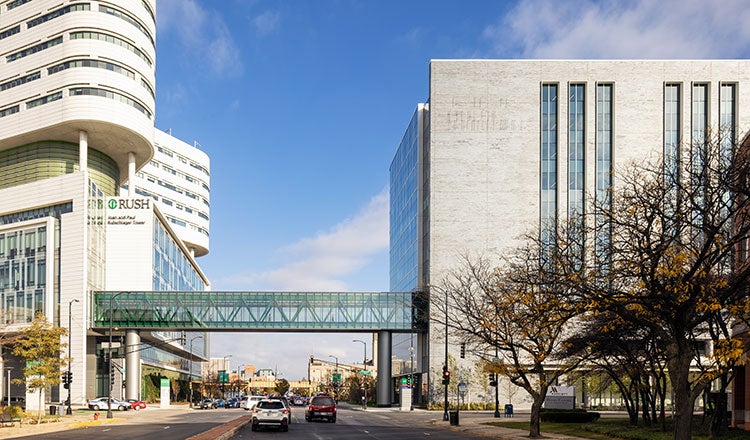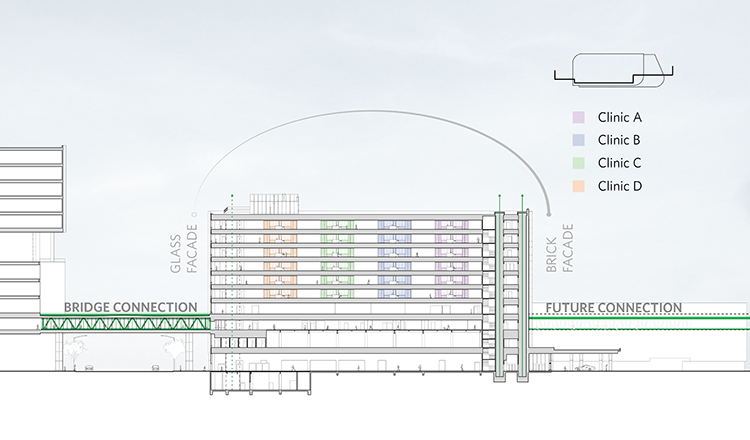Rush University Medical Center Joan & Paul Rubschlager Building

Rush University Medical Center Joan & Paul Rubschlager Building
Translational, Technologically Advanced, Flexible, and Prepared for the Future
On an 11-acre site at the nation’s largest urban medical district, the new Joan & Paul Rubschlager Building contains almost a half million square feet of diagnostic, treatment, procedure, clinic, lab, pharmacy, and administrative and faculty office space for Rush University Medical Center in Chicago to provide outpatient care for cancer and neurosciences. This new facility, connected by a pedestrian bridge over Ashland Avenue to the existing patient tower, completes the next phase of this fully-integrated, self-contained campus.

Translational health sciences experts implemented planning strategies to design spaces in which clinical care, research, and education are brought together in a translational care environment to improve collaboration, accelerate discovery, and provide patients access to new treatment options.

Robust Technology Integrated With Safety and Resiliency
Smart technology begins at the entrance into the new destination cancer and neurosciences facility where the real-time tracking system supports patients and visitors as they navigate through temperature sensors for COVID-19 screening, to guest relations and finally check-in and check-out. Safety and security were paramount during the planning and design process so pedestrian flow and intake includes designated queuing and sub-waiting areas, greeter stations at all clinic modules, and key card access at all entrances into every patient access point.
Constructed to seek LEED v2009 certification with a goal of Gold, this sustainably designed healthcare facility satisfies all energy mandates, materials, recycling, environmental, and atmospheric necessities, including surface bioswales and underground water retention.
Designed for resiliency, redundant mechanical systems with ionizing filtration capability, negative pressure controls and airlocks are integrated into the facility along with reliable power and uninterruptible power supply back-up to all critical technology systems. Linear accelerators that use external beam radiation to deliver high-energy x-rays and electrons to tumor locations are housed in vaults constructed of high-strength concrete and lead blocks. MRI, CT scanners, and a positron emission tomography scanner used for nuclear medicine diagnostics are also in lead-lined enclosures with various shielding thicknesses as prescribed by the physicist. Simulation and preparation capabilities include a hot lab with special purpose measuring equipment. These systems are certified after construction to verify no leakage occurs.

Goals for Success and Community Improvement
Four pillars of success were established at the visioning charrette: people, growth and reach, quality and safety, and financial strength. Key criteria associated with these core strategies were enhancing innovation, employee engagement, technology integration, adaptability and flexibility, future proofing, cost reduction, and time to market. These criteria were applied in a decision matrix to inform all major planning and design decisions.
Community engagement and improvement was a critical aspect of the planning and design phase. Regular meetings were held to ensure RUMC’s quality relationship with the surrounding community remained intact and that the new facility would add value to the location, be appealing and welcoming and aesthetically beneficial, and also avoid blocking the already limited views for residents of the Near West Side neighborhood.
Campus-wide transportation improvements include pedestrian friendly walkways, Pace van drop-off and pick-up lanes, vehicular turning, exiting and speed ramp lanes into the parking garage along with a Type 2 ambulance accommodation at the off-stage radiation oncology entrance. Due to the size of the facility the parking garage was designed to provide a bypass through the site and an existing boulevard on the main walk-in entry side was bifurcated to allow a reroute of traffic patterns that would benefit the neighborhood.






















